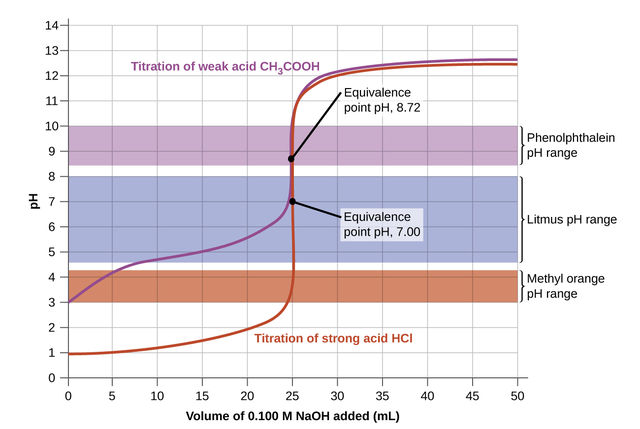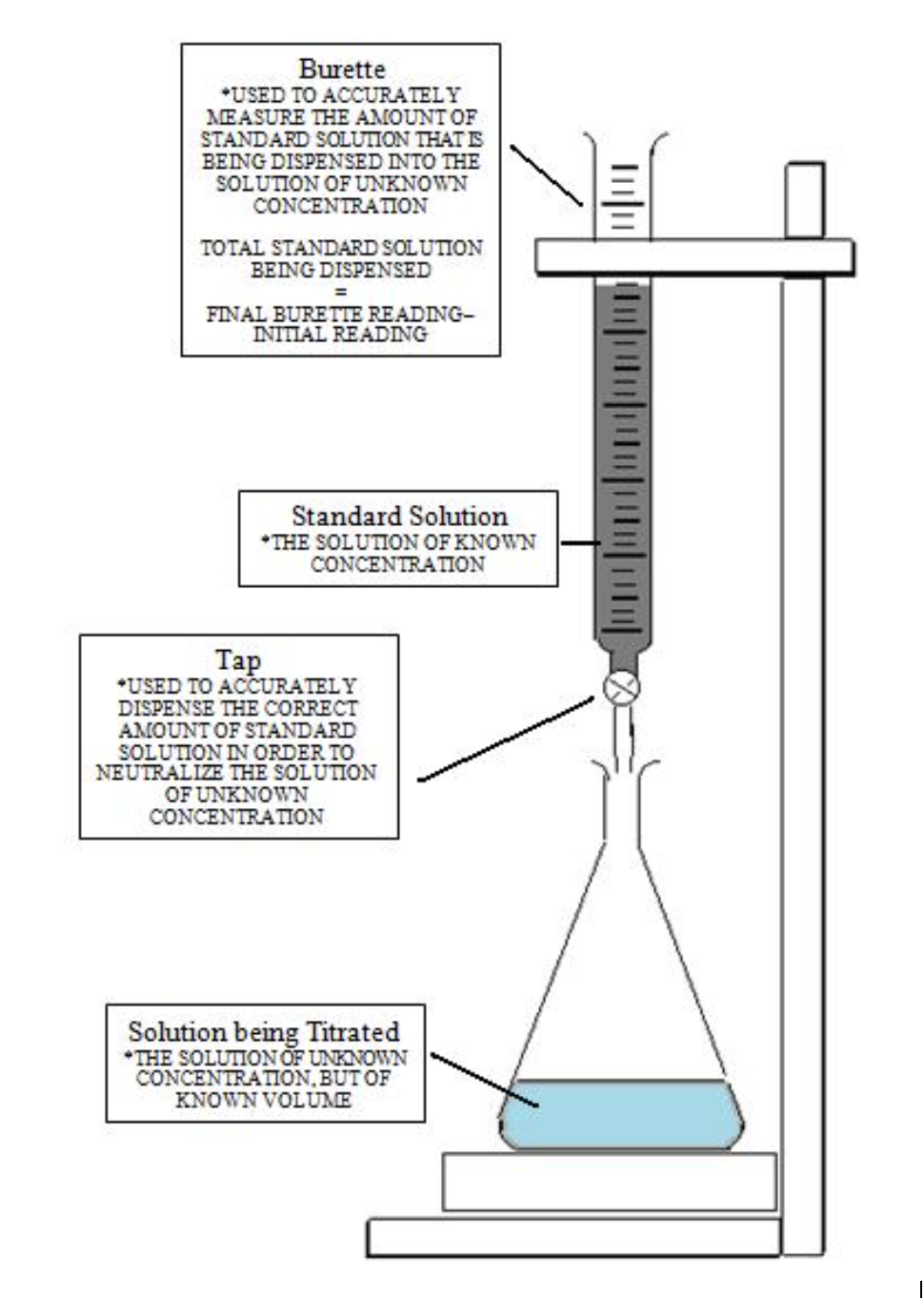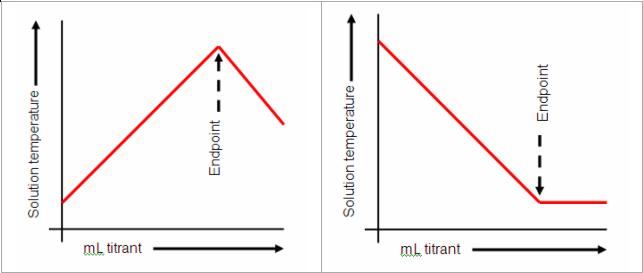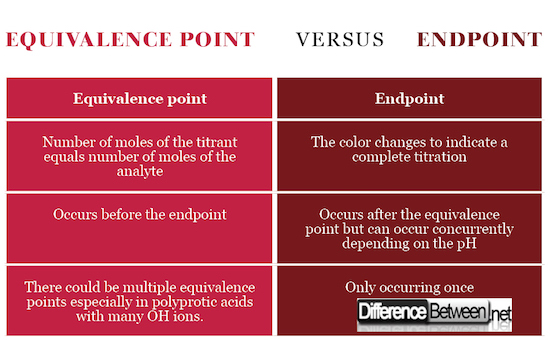Difference Between Endpoint and Equivalence Point
Endpoint and equivalence point are the two most important concepts in chemistry titrations. The technique of titrations can occur in redox reactions, acid-base reactions, and many more reactions. It is predominantly used in acid-base reactions where it involves neutralization of another solution with the other to determine the unknown concentration. Basically, a standard solution with known concentration is carefully poured into another solution called the analyte with unknown concentration to calculate its concentration.
During titration process, there are two stages that are reached, viz. endpoint and equivalence point. Equivalence point, also called stoichiometric point, in a nutshell, is a point where the moles of the two solutions, acid and base, are equivalent or equal. The stage occurs before the endpoint, which signals the completion of the reaction. In some reactions, there could be numerous equivalence points, especially in polyprotic acids and bases where multiple hydroxide ions exist.
This article unfolds the key difference between the endpoint and equivalence point in chemical titrations.
Definition of Equivalence point
Equivalence point in acid-base titration signals the completion of the reaction where the number of moles of the titrant and the analyte are equal as in the chemical equation. For example, in a titration of NaOH and HCl, 1 mole of HCl will be equal to exactly 1 mole of NaOH at the equivalence point. This point must be attained accurately by administering a number of drops of the standard solution to the unknown concentration. A pipette is usually used to pour drops of the titrant into the measuring flask where the analyte has been poured with a certain indicator. Indicators are important in acid-base titrations to clearly see the equivalence and endpoints.
Acid and base titration can occur between a strong base and weak base; strong base and weak acid; strong base and strong base; or weak polyprotic acids. A different indicator may be used depending on the typical of solution being used for titration. For instance, in a NaOH and HCl titrations, a phenolphthalein is used, whereas in NH3 and HCl a methyl orange indicator is more suitable to effect changes. If the pH of the titrant corresponds with the pH at equivalence point, the endpoint and equivalence point can occur simultaneously.
The picture below gives a clear understanding of titration set up in order to reach the equivalence point and then later reach the endpoint when the color changes. At first, the solution with the unknown concentration is poured with the indicator. Then the titrant is added using the burette by controlling the drops with the valve. The equation MacidVacid = MbaseVbase is used to calculate the unknown concentration by algebraic manipulations noting that Molarity is a number of moles per liter.
Definition of Endpoint
Endpoint comes after the equivalence point in titrations. It indicates that the equivalence point has been achieved. This endpoint is indicated by the change in color of the solution. See the picture below:
Image Courtesy: Chemistry LibreTexts
To reach the endpoint, the amount of drops should be administered carefully because a single drop can change the pH of the solution. In situation where the endpoint has been passed, a Back Titration or reverse titration can be performed depending on the nature of the solution. If too much of the titrant has been poured, the endpoint might be passed. The solution will be to add another solution of a different reactant in excess.
Indicators are not always used in titrations. The pH meters can be used to read the pH as an indication that the reaction is complete. In a strong base and acid, a pH of 7 indicates that the reaction is complete. The color change is, however, a convenient way to monitor the endpoint hence the indicators are often used. A solution of sodium chloride and hydrochloric acid reach endpoint as indicated by the phenolphthalein when the solution turns pink. The endpoint does not necessarily indicate the end of the reaction, but the completion of titration.
Difference between endpoint and equivalence
Definition of endpoint and equivalence
Endpoint is the stage in titration that is indicated by a color change as a sign that titration is complete and the equivalence point has been achieved. Equivalence point, on the other hand, is the stage just before the endpoint that signals the stoichiometric point with equal number of moles between the analyte and the titrant in line with the chemical equation. To reach the equivalence point, the titrant must be poured accurately and precisely drop by drop using the burette.
Occurrence of endpoint and equivalence
Equivalence point occurs when the number of moles of the titrant, the standard solution, is equal to the number of moles of the analyte, the solution with unknown concentration. Endpoint occurs when the color change.
Meaning of endpoint and equivalence
Equivalence point means that the titrant has reacted fully with the analyte whereas the endpoint signals the completion of titration. Endpoint and equivalence can occur at the same time if the pH of the titrant corresponds to the pH at equivalence point.
Endpoint verses Equivalence: Comparison Chart
Summary of endpoint Verses equivalence
- Endpoint and equivalence point are the most important stages in chemical titrations
- Endpoint happens after the equivalence point and it indicates the completion of titration, but not always the end of the reaction.
- Equivalence point occurs before the endpoint and it indicates the complete reaction between the titrant and the analyte where the number of moles of the titrant is equal to the number of moles of the unknown concentration
- Endpoint is reached when the color changes if the indicator has been used
- Other weak acids can have multiple equivalence points but only one endpoint
- Equivalence point is also called the stoichiometric point
- Difference Between CBD and Indica - April 22, 2019
- Difference Between Unilateral Contract and Bilateral Contract - February 8, 2019
- Difference Between Polki and Kundan - December 15, 2018
Search DifferenceBetween.net :
Leave a Response
References :
[0]Brady, James E., and John R. Holum (1993). Chemistry The Study of Matter and Its Changes. New York: John WIley & Sons, Inc.
[1]Clayden, J., Warren, S., et al. (2000). Organic Chemistry. Oxford University Press
[2]Meyers, R., (2003). The Basics of Chemistry. Greenwood Press
[3]Image credit: https://upload.wikimedia.org/wikipedia/commons/thumb/8/8f/CNX_Chem_14_07_titration2.png/640px-CNX_Chem_14_07_titration2.png
[4]Image credit: https://commons.wikimedia.org/wiki/File:Aaaathermo_fig1a-1b.jpg#/media/File:Aaaathermo_fig1a-1b.jpg





